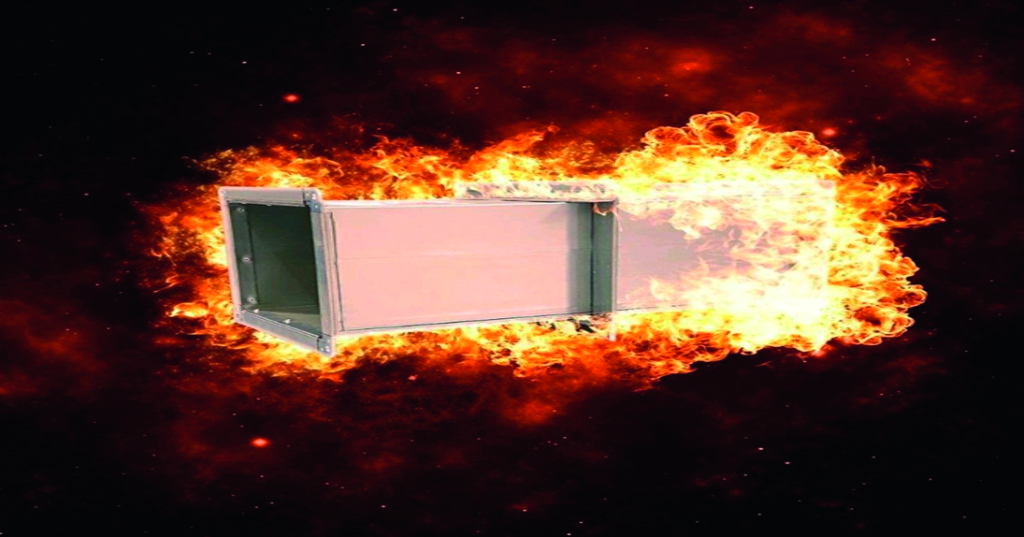The key role of the passive protectors

Paul Downing, a member of the DW 145 drafting panel, explains the requirements and information considered beneficial for building facility managers and those responsible for maintenance.
Following amendments and rebranding, the BESA DW145 is expected to be published as a building services specification by the Building Engineering Services Association (BESA) and launched in 2024. It will cover design, specification and selection of fire dampers to include installation, inspection and testing.
Fire dampers are installed into the ductwork of ventilation systems to help delay the spread of smoke and fire to allow people sufficient time to safely evacuate a building in the event of a fire. If a fire was to break out in a building with no fire dampers installed, it can quickly and easily pass through duct systems, spreading rapidly throughout the premises, and infiltrating fire-resistant walls and floors into escape routes.
Fire dampers are designed to delay this by closing shut when a fire occurs. This helps to hold back the fire, reduce it from spreading into escape routes and causing greater damage to property and the building itself. Most importantly, they protect the lives of those inside by preserving the integrity of fire escape routes.
As with any safety apparatus, fire dampers need to be regularly inspected, tested on an annual basis as a minimum and maintained to ensure that when the time comes, they will work effectively for the purpose of passive fire protection.
Compartmentation
Commonly called “penetration seals”, compartmentation is required where ventilation passes through compartment boundaries.
Building regulations and guidance such as Approved Document B describe the control of fire by compartmentation that keeps the fire in the space of origin and preventing it from spreading to other areas. This is generally achieved using passive fire protection principles such as fire dampers, fire stopping materials and penetration seals.
When ductwork penetrates through a compartment boundary (fire resisting wall or floor), the compartmentation is broken, therefore it must be re-instated. This requires very careful consideration of the information provided by the ductwork provider and fire damper manufacturer. Dampers and associated penetration seals must be installed to match the same level of protection as the compartment boundary provided.
Fire Damper Activation
Fire dampers are fitted into ventilation ductwork in areas where they pass through fire-rated walls and floors which are fire compartment barriers.
They work by springing closed (like a roller shutter) to stop the flow of fire or smoke and can be activated in two ways:
1. When a given temperature is reached, a ‘fusible link’ which holds the shutters apart will melt and trigger them to slam shut.
2. Electronic dampers are activated by smoke and fire detectors (sensors) which are linked to a trigger mechanism that closes the shutters.
Legislative compliance and standards
Some of the following regulations and standard guidance include, but are not limited to, the following:
- The Regulatory Reform (fire safety) Order (RRO) 2005 This came into effect in October 2006 and had a major impact on responsibility for fire safety. The RRFSO changed the responsibility for a facility’s fire safety system to the organisation’s “responsible person”.
Typically, the responsible person is the employer, or the owner of the facility. Fire safety systems must be kept in order and include all active and passive fire protection systems.
Included in the list of items in the passive fire protection systems are the maintenance of the fire and smoke dampers.
In general terms, the RRFSO reflects the duties and approach contained within the Management of Health and Safety at Work Regulations 1999 and employee’s duties under the Health at Work Act 1974 and the Building Safety Act 2022.
2. Building Regulations 2022 - Fire Safety Approved Document Volume 2: Buildings other than dwellings. Part B: Fire Safety:
“The damper assembly shall have a fire integrity classification equal to the fire barrier it penetrates. ”
Also referred to simply as ‘Part B’, this government document is designed to give guidance on fire precautions relating to the wider Building Regulations in England. Collectively these must be adhered to keep people and premises safe – including occupants or residents, visitors, and fire-fighting services as well as those in the vicinity of premises. The document also addresses the internal spread of a fire due to the structure or lining used within a building and safety measures related to this.
3. BS: 9999 Code of Practice for Fire Safety in the Design, Management, and use of Buildings

Any grille or opening through the enclosure for ventilation purposes should be protected by a fire damper. BS 9999 defines a fire
damper as a mechanical device that is operated automatically or manually and is designed to prevent the passage of fire which, together with its frame, is capable of meeting for a stated period the fire resistance the criterion for integrity.
“All fire dampers should be tested by a competent person on completion of the installation and at least annually, they should be repaired or replaced immediately if found to be faulty.
“Spring operated Fire Dampers should be tested annually, and Fire Dampers situated in dust laden or similar atmospheres should be tested much more frequently, at periods suited to the degree of pollution.”
4. BS: 7974 - Application of fire safety engineering principles to the design of buildings
A framework for an engineering approach for the fire safety of buildings, giving recommendations and guidance on applying scientific and engineering principles for the protection of people, property, and the environment from fire. It applies to the design of new buildings and the appraisal of existing buildings and primary users include fire safety engineering practitioners.
5. Association for Specialist Fire Protection (ASFP) Grey Book: EN Fire Dampers
EN Fire Dampers As used in ventilation systems to maintain fire compartments and/or to protect means of escape from buildings. Gives guidance on EN fire testing, classification, application, and installation.
6. Association for Specialist Fire Protection (ASFP) Red Book
Fire Stopping Is the definitive guide to the provision of proprietary materials and systems used to provide fire stopping and sealing of penetrations within fire separating elements to comply with building regulations.
7. NHS Estates HTM 03-01 Heating and ventilation of health sector buildings
Part B Operational management and performance verification’ calls for all fire dampers to be tested annually.
8. NHS Estates HTM 05-03 Fire Code
Guidance in support of functional provisions (Fire safety in the design of healthcare premises).
All structural fire protection and elements of fire compartmentation should be inspected and any remedial action carried out annually.
9. BESA VH001 – Fire and Smoke Damper Maintenance
The key change in the updated VH001 third edition is the requirement for testing to include reporting on where dampers have been incorrectly installed without break-away joints.
10. BESA DW145 – Guildance for the installation of fire and smoke dampers
Currently under review, amendment and re-branding, it is envisaged that VH 001 (4th Edition) Fire Damper Maintenance content will also be incorporated into the amendments and re-branding of BESA DW/145 specification.
11. National Occupational Standards (NOS)
Developed by a team of UK industry experts (Employers, trade associations, unions, and other key stakeholders) to capture the relevant competencies for those whose role includes working on fire and smoke control dampers across the UK.







